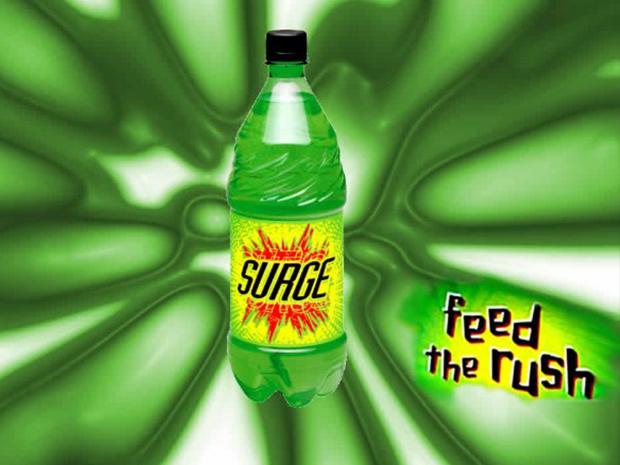I Fed the Rush: A Short Memoir On My Relationship with the ‘90s Soda-Icon Known as Surge
The 90s were the decade of many crude nods to some sort of neo-counter-culture/burgeoning-cyber-culture. Skateboards were mixed with savage sans serif font to indicate that some something savage yet marketable was going on. It was a cyborg Sixties hippie complete with bellbottom jeans and floppy-haired white boys. I was in middle school in the midst of all this. My costume was JNCO jeans and Rusty t-shirts. My argot was South Park and Beavis and Butthead. I was ripe for something that promoted energy yet edge. I was prime for the phenomenon known as Surge.
Trying to explain Surge to the current crop of teens and early twenty-somethings is probably like those who came of age in the ‘80s trying to explain Tab to my generation; it was a thing that happened indicative of the neuroses of an era.
For those who don’t know, Surge paved the way for Vault and Jolt (which my RA and close friend consumed whole twelve-packs of weekly it seemed), which probably laid the groundwork for the fetid cult of energy drinks. The label for Surge looked like Mountain Dew on crack. It was the American import of a Norway soda known as Urge. Both carried a blatant marketing plea to the rise in popularity of extreme sports. Drinking Surge was like imbibing the essence of Mountain Dew cubed and my first introduction to it was the result of a conspicuous marketing campaign during seventh-grade gym class.

I was seated on the bleachers in my aforementioned JNCO attire, lazily watching my fellow classmates enthusiastically play basketball (a sport I was only competent at in my driveway, by myself). The whole scene is faded now and gloms together with so many other nice and horrific memories of middle school, but I do remember it was near the end of the school year…
My school had already entered into an agreement with Coca Cola to have their soda vending machines on campus, so it wasn’t that much of a stretch when bottles of this drink I’d never heard of were passed out to us. I don’t remember any one telling us that this was special or that Coca Cola was trying something out on us. Just the memory of the door of the gymnasium that led outside, a bright veneer of May sun across the peeling wax floor and, suddenly, the feel of a caffeinated drink in my hand.
Surge became my drink of choice for the remainder of my middle school career. It, in fact, formed my entire Friday evening ritual, which was (at least in the fall and the spring) that I would ride my bike to the gas station downtown, pick up an enormous bottle of Surge and two King-Size Snicker’s bars, speed back to my house, lock my door and play Resident Evil or some incarnation of the Mortal Kombat franchise. It was probably a sweetly sad scene to watch. I compare it to that scene from Freaks and Geeks when Bill Haverchuck makes himself a cheese sandwich and a glass of milk to Garry Shandling do standup on the Dinah Shore Show. There was something unattached, amorphous and free about it; a caveat that’s only considered appropriate in that stage of development shortly before nothing is too serious but everything is on the edge of mattering.
Surge disappeared from my life in high school. In fact, it seems the disappearance was pretty drastic. I remembered seeing it everywhere. Then, I didn’t see it again except when I was traveling with my family and stopped at a convenience store somewhere in North Carolina or Virginia and would see a Surge slushie machine tucked into the store’s back corner. The anachronistic label faded. It’s been here a while, I would think and quietly saunter to the cooler for a Mountain Dew or Canada Dry.

For a while now, I think stages of development have been unofficially sponsored by products. Sony, Apple, Coca Cola, American Eagle, True Religion, etc.. Everybody has some sort of brand their adolescence was brought to them by, everyone has a brand their place in existence was stamped on their psyche. Sometimes I wish it was something more important, less superfluous than a monetary product. I try now to make memories more about gestures than specifics of transaction. Most of my twenties were coffee and I’m okay with that fact. Thirties? Orange shirts, I’m thinking.
Surge, though. There’s something beautiful and fleeting about its disappearance. I say “disappearance” even though Surge has experienced small revivals in select sections of the country and for a limited time on Amazon. As far as the consciousness marketing-wise, it has disappeared – unlike Mountain Dew, the product it was meant to displace – from our awareness. Personally, Surge is like Pennywise: an entity that keeps circling back and whispering into my ear every few years or so. I sometimes wonder if Surge captured a developmental cliff; if the strange soup of adolescent self-discovery and inevitably mismanagement of said institutions of discovery by adults who may or may not have fully passed beyond their own adolescence.
